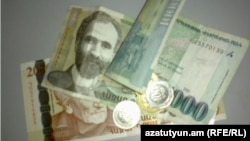In what the Armenian authorities hope will be a boost to domestic manufacturers, the national currency, the dram, has slowly but steadily depreciated over the past year despite rising exports and private remittances from abroad.
The dram was trading on Tuesday at an average of 389 per one dollar, making it 6.2 percent weaker, in nominal terms, against the U.S. currency than a year ago. It has lost 3.7 percent in nominal value in the last three months.
The Armenian currency dramatically appreciated against the dollar and the euro during several consecutive years of double-digit economic growth that came to an end in late 2008. The global financial crisis caused it to fall sharply in the following months.
The dram rallied against both hard currencies as the country began recovering from recession in 2010. In a December 2010 report, the International Monetary Fund warned that it has grown overvalued by 10-12 percent.
President Serzh Sarkisian acknowledged last March that the dram’s strengthening in 2010 and before had a negative impact on Armenian manufacturing firms. Sarkisian predicted its “very slow and stable depreciation” in the months to come. The dollar was worth 368 drams at the time.
The Central Bank of Armenia (CBA) appears to have eased its interventions in the domestic currency market. The bank sold a total of almost $8 million in hard currency at Yerevan’s NASDAQ OMX stock exchange last week. It insists that it is only seeking to prevent drastic and short-term exchange rate fluctuations.
“If that is done for preventing exchange rate fluctuations, then it’s an acceptable approach,” said Bagrat Asatrian, a former CBA governor affiliated with the Armenian opposition. “Not to mention many other factors that warrant Central Bank intervention.”
Asatrian also downplayed the dram’s continued weakening this month, saying that seasonal factors are also at play. “There is no cause for concern,” he told RFE/RL’s Armenian service (Azatutyun.am).
The dram was trading on Tuesday at an average of 389 per one dollar, making it 6.2 percent weaker, in nominal terms, against the U.S. currency than a year ago. It has lost 3.7 percent in nominal value in the last three months.
The Armenian currency dramatically appreciated against the dollar and the euro during several consecutive years of double-digit economic growth that came to an end in late 2008. The global financial crisis caused it to fall sharply in the following months.
The dram rallied against both hard currencies as the country began recovering from recession in 2010. In a December 2010 report, the International Monetary Fund warned that it has grown overvalued by 10-12 percent.
President Serzh Sarkisian acknowledged last March that the dram’s strengthening in 2010 and before had a negative impact on Armenian manufacturing firms. Sarkisian predicted its “very slow and stable depreciation” in the months to come. The dollar was worth 368 drams at the time.
The Central Bank of Armenia (CBA) appears to have eased its interventions in the domestic currency market. The bank sold a total of almost $8 million in hard currency at Yerevan’s NASDAQ OMX stock exchange last week. It insists that it is only seeking to prevent drastic and short-term exchange rate fluctuations.
“If that is done for preventing exchange rate fluctuations, then it’s an acceptable approach,” said Bagrat Asatrian, a former CBA governor affiliated with the Armenian opposition. “Not to mention many other factors that warrant Central Bank intervention.”
Asatrian also downplayed the dram’s continued weakening this month, saying that seasonal factors are also at play. “There is no cause for concern,” he told RFE/RL’s Armenian service (Azatutyun.am).




